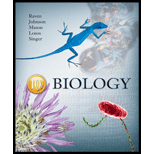
Concept explainers
In the
a. Reproduction
b. Digestion
c. Locomotion
d. Osmoregulation
Introduction:
Flatworms are free-living organisms, which are present in a wide variety of marine, fresh waste, and terrestrial habitats. Flatworms are carnivores that depend upon small animals and organic debris. Excretion and osmoregulation are the types of metabolic processes that occur in flatworm by flame cells.
Answer to Problem 1U
Correct answer:
In the flatworm, flame cells are involved in osmoregulation, which is a metabolic process. Therefore, option d. is correct.
Explanation of Solution
Reason for the correct statement:
Flame cells, which are present in the flatworm poses an excretory system. Flame cells contain flagella that cause the movement of water and excretory substances within the tubules. Further, it moves to the pores present between the epidermal cells by which the liquid is thrown out.
Option d. is given as “osmoregulation”.
In the flatworm, metabolic processes such as excretion and osmoregulation occurs and is regulated by the flame cells that are the bulblike structures located on the side branches of the tubules”, which is the right answer.
Hence, option d. is correct.
Reasons for the incorrect statements:
Option a. is given as “Reproduction”.
Reproduction is not a metabolic process and flame cells are not responsible for the reproduction in the flatworms. Therefore, it is a wrong answer.
Option b. is given as “Digestion”.
Flatworm contains a single body, a mouth that is responsible for digestion. Therefore, it is a wrong answer.
Option c. is given as “Locomotion”.
Locomotion or movement is not a type of metabolic processes in flatworms. Therefore, it is a wrong answer.
Hence, options a., b., and c. are incorrect.
Conclusion:
Flame cells are the bulb-like structures that contain flagella with flickering movements defeating inside the cell. These are located across the branches of the tubules.
Want to see more full solutions like this?
- Molecular Biology Question A gene that codes for a protein was removed from a eukaryotic cell and inserted into a prokaryotic cell. Although the gene was successfully transcribed and translated, it produced a different protein than it produced in the eukaryotic cell. What is the most likely explanation?arrow_forwardMolecular Biology LIST three characteristics of origins of replicationarrow_forwardMolecular Biology Question Please help. Thank you For E coli DNA polymerase III, give the structure and function of the b-clamp sub-complex. Describe how the structure of this sub-complex is important for it’s function.arrow_forward
- Molecular Biology LIST three characteristics of DNA Polymerasesarrow_forwardMolecular Biology RNA polymerase core enzyme structure contains what subunits? To form holo enzyme, sigma factor is added to core. What is the name of the structure formed? Give the detailed structure of sigma factor and the function of eachdomain. Please help. Thank youarrow_forwardMolecular Biology You have a single bacterial cell whose DNA is labelled with radioactiveC14. After 5 rounds of cell division, how may cells will contain radioactive DNA? Please help. Thank youarrow_forward
- 1. Explain the structure and properties of atoms and chemical bonds (especially how they relate to DNA and proteins). Also add some pictures.arrow_forward1. In the Sentinel Cell DNA integrity is preserved through nanoscopic helicase-coordinated repair, while lipids in the membrane are fortified to resist environmental mutagens. also provide pictures for this question.arrow_forwardExplain the structure and properties of atoms and chemical bonds (especially how they relate to DNA and proteins). Also add some pictures.arrow_forward
- In the Sentinel Cell DNA integrity is preserved through nanoscopic helicase-coordinated repair, while lipids in the membrane are fortified to resist environmental mutagens. also provide pictures for this question.arrow_forward1. Explain how genetic information is stored, copied, transferred, and expressed. Also add some pictures for this question.arrow_forward!. Describe biological macromolecules (DNA, RNA, proteins, lipids, etc.) and how they function in the cell. also provide some images for this question.arrow_forward
 Concepts of BiologyBiologyISBN:9781938168116Author:Samantha Fowler, Rebecca Roush, James WisePublisher:OpenStax College
Concepts of BiologyBiologyISBN:9781938168116Author:Samantha Fowler, Rebecca Roush, James WisePublisher:OpenStax College
 Comprehensive Medical Assisting: Administrative a...NursingISBN:9781305964792Author:Wilburta Q. Lindh, Carol D. Tamparo, Barbara M. Dahl, Julie Morris, Cindy CorreaPublisher:Cengage Learning
Comprehensive Medical Assisting: Administrative a...NursingISBN:9781305964792Author:Wilburta Q. Lindh, Carol D. Tamparo, Barbara M. Dahl, Julie Morris, Cindy CorreaPublisher:Cengage Learning Biology Today and Tomorrow without Physiology (Mi...BiologyISBN:9781305117396Author:Cecie Starr, Christine Evers, Lisa StarrPublisher:Cengage Learning
Biology Today and Tomorrow without Physiology (Mi...BiologyISBN:9781305117396Author:Cecie Starr, Christine Evers, Lisa StarrPublisher:Cengage Learning





